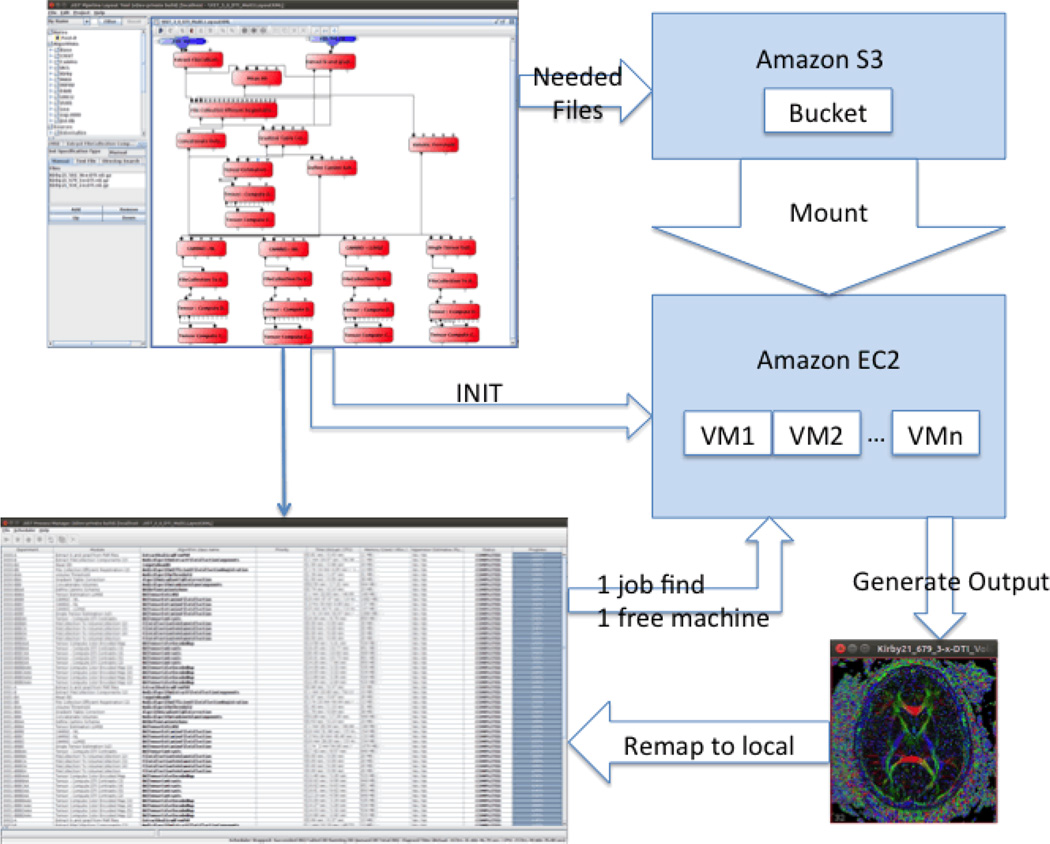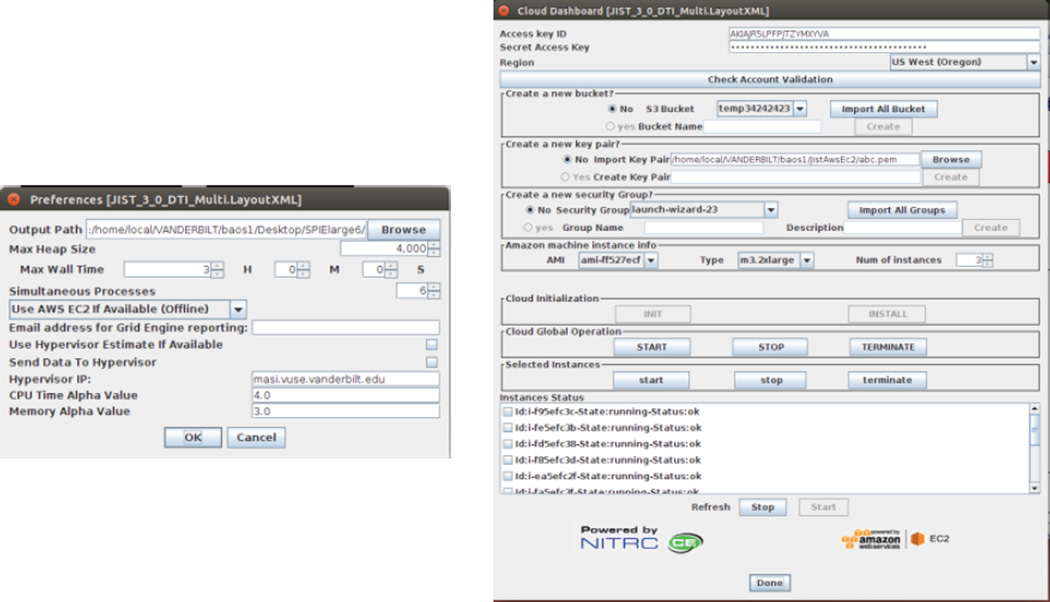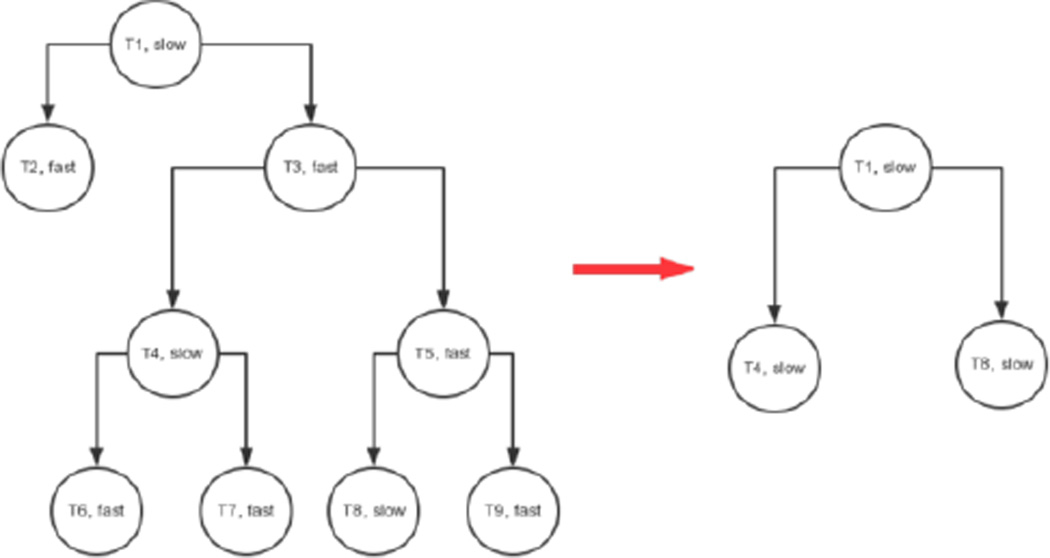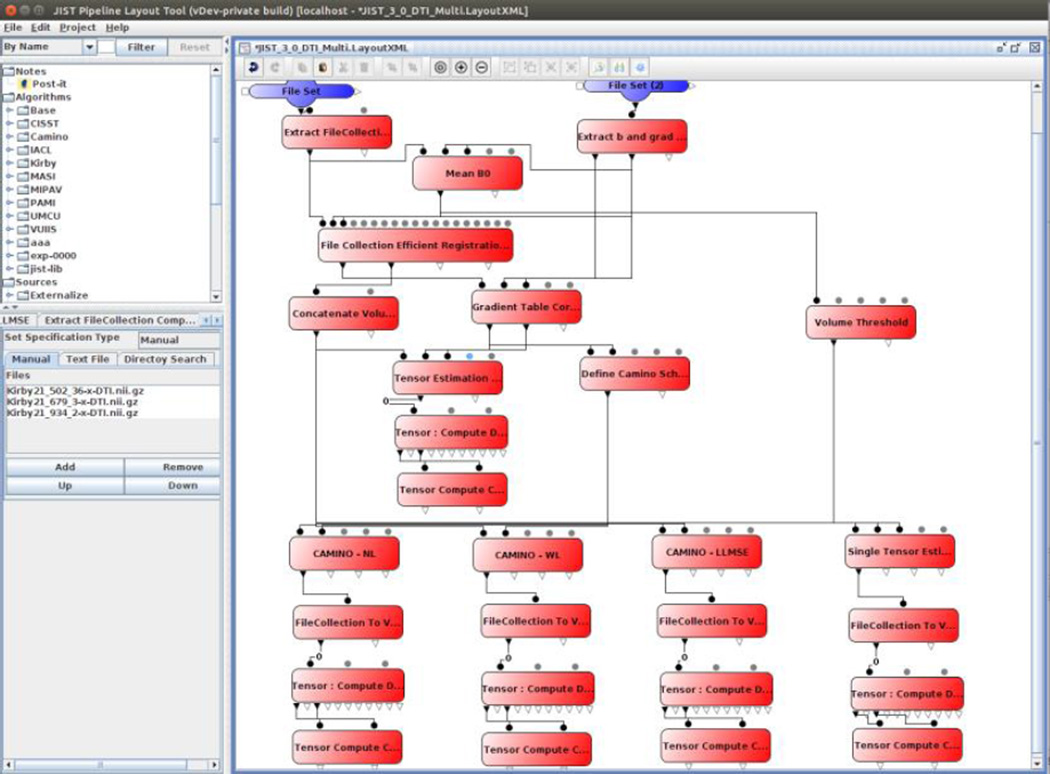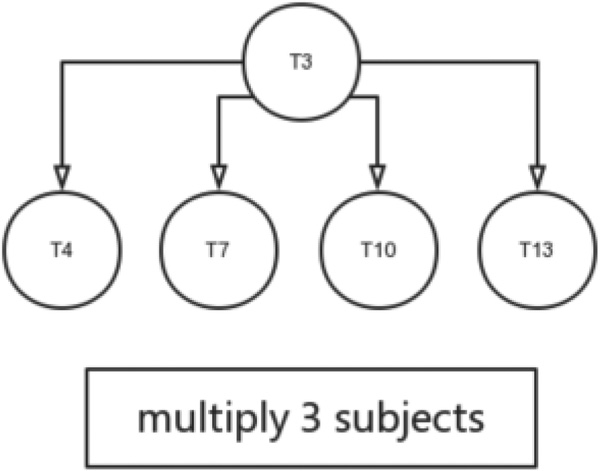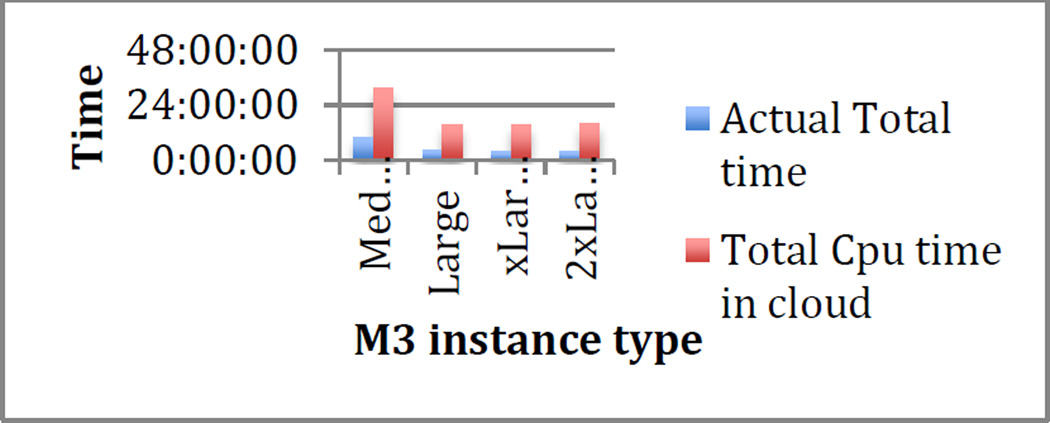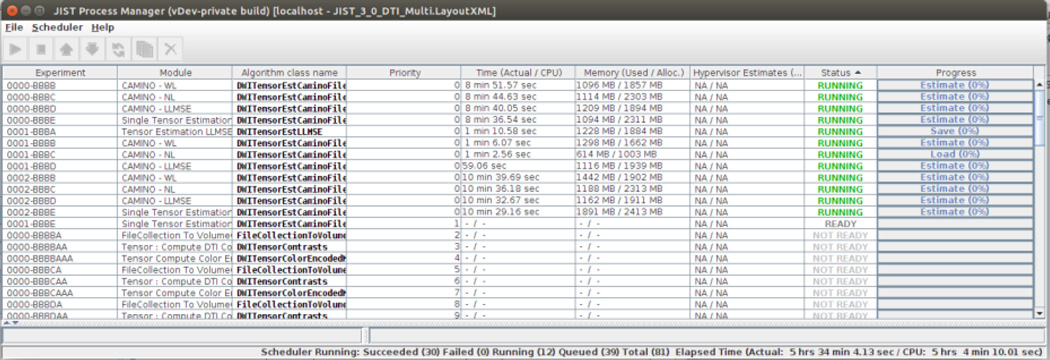Abstract
Adopting high performance cloud computing for medical image processing is a popular trend given the pressing needs of large studies. Amazon Web Services (AWS) provide reliable, on-demand, and inexpensive cloud computing services. Our research objective is to implement an affordable, scalable and easy-to-use AWS framework for the Java Image Science Toolkit (JIST). JIST is a plugin for Medical-Image Processing, Analysis, and Visualization (MIPAV) that provides a graphical pipeline implementation allowing users to quickly test and develop pipelines. JIST is DRMAA-compliant allowing it to run on portable batch system grids. However, as new processing methods are implemented and developed, memory may often be a bottleneck for not only lab computers, but also possibly some local grids. Integrating JIST with the AWS cloud alleviates these possible restrictions and does not require users to have deep knowledge of programming in Java. Workflow definition/management and cloud configurations are two key challenges in this research. Using a simple unified control panel, users have the ability to set the numbers of nodes and select from a variety of pre-configured AWS EC2 nodes with different numbers of processors and memory storage. Intuitively, we configured Amazon S3 storage to be mounted by pay-for-use Amazon EC2 instances. Hence, S3 storage is recognized as a shared cloud resource. The Amazon EC2 instances provide pre-installs of all necessary packages to run JIST. This work presents an implementation that facilitates the integration of JIST with AWS. We describe the theoretical cost/benefit formulae to decide between local serial execution versus cloud computing and apply this analysis to an empirical diffusion tensor imaging pipeline.
Keywords: Cloud deployment, Amazon Web Service, High performance computing, NITRC-CE
1. Introduction
The increasing accumulation of open-source multi-modal images makes it imperative to deploy local processing of images into cloud-based environments. An example of such a image processing framework is the Java Image Science Toolkit (JIST) [1–3], a biomedical plugin for MIPAV[4], which is entirely developed in the Java programming language[5,6] and is hosted on the Neuroimaging Informatics Tools and Resource Clearinghouse (NITRC). Amazon Web Services (AWS) provide reliable, on-demand, and affordable cloud computing services [7] that is promising for medical image processing. Different types of optimized Amazon Elastic Cloud Computing (EC2) instances are offered in AWS [8]. Amazon Simple Storage is easy to apply, cost oriented, and highly scalable as data/object storage [9]. Despite the promise, workflow definition/management and cloud configurations are two key challenges in this realm. We exploited the NITRC Computational Environment (NITRC-CE) [10,11] hosted by Amazon’s AWS, to distribute each JIST “Execution Context” (process) on a separate cloud node. Through an applicable cost/benefit analysis, users are able to specify a grid size, automatically boot up a private network, install JIST into MIPAV, and set up all requirements for processing. All monitoring is managed through the standard JIST Process Manager.
Our contributions are summarized as follows.
We provide a concrete workflow definition/management for JIST to deploy a local project to be distributed and processed in the cloud.
We integrate JIST to Amazon AWS (a reliable, on-demand, and inexpensive cloud computing services) to execute high performance computing.
We demonstrate a cost/benefit analysis of a pipeline that can be easily parallelized and requires memory that would limit the processes to serially execute only on a local lab machine.
This paper is organized as follows. In Section 2, we introduce in detail the JIST cloud deployment framework with a glimpse of its implementation. We present cost/benefit analysis especially focusing on project total running time estimation. Section 3 describes performance analysis for a multi-subject diffusion tensor imaging experiment.
2. Method
2.1 Workflow framework
Cloud configuration is based on Amazon AWS (of which S3 storage and EC2 are two components). Amazon S3 storage is mounted by every pay-for-use Amazon EC2 instance. Hence S3 is recognized as a shared cloud resource for all EC2 machines that are ordered by clients. S3 stores all necessary packages including MIPAV’s install file, JIST plugins, JIST Library and other files related to configuration. Each Amazon EC2 machine can get the source packages from S3, and install related packages to run JIST.
Briefly, JIST pipelines are stored in a “layout” file, which specifies inputs and outputs as well as algorithm classes used for execution. The user’s layout is later sent to S3 storage, and all processing is handled in the cloud virtual machines. The local host (local machine) meanwhile monitors the processing process in cloud. Rather than run whole layout on a typical cloud machine, each processing command (a JIST “execution context”, which is a single process in the process manager) generated by the JIST scheduler is distributed to any of the free EC2 instances. The process manager periodically sends jobs that are ready to run to the cloud when idle machines are found. Each job has a local monitor that periodically pulls back its debug and error info in the cloud so that users can view the progress of a running job. Status “Complete” represents a process that has completed, and all files that have been produced during the proceeding have been replicated back to local workstation. Note, to copy files between systems, the directory paths must be modified to represent differences in mount points and local structures. Thus, outputs are available to operate on locally even though processing happens on AWS. The workflow framework is presented in Figure 1.
Figure 1.
Workflow framework.
2.2 Configuration
Several modes to run a layout can be selected in the JIST layout preference panel (e.g., run on a DRMAA compliant grid, run locally, or run in the Amazon Cloud). Users should choose “use AWS EC2” option to activate cloud computing (Figure 2-(a)).
Figure 2.
(a) JIST preferences panel (b) JIST Cloud Dashboard
Using the Cloud Dashboard, users are able to configure, initialize (“init”), boot, and terminate an Amazon AWS NITRC-CE cloud instance with predefined machine information (Figure 2(b)). Access Key Id, Secret access key and region information are used to validate an AWS account so that user can access Amazon EC2 and S3 resources. Custom S3 buckets are a top-level folder on S3, the name of which must be globally unique in Amazon S3. This bucket is used to store necessary packages and JIST layout projects with the same structure. A standard cryptographic key pair is needed to securely log in and connect to remote cloud instances. Inbound and outbound connection rules including IP and port permission range are defined in security groups. Also, users can select several different types of pre-configured Amazon machines and any number of identical machines to boot. These machines have different processor speeds and memory installments. The initialize and install processes are executed once all necessary files and settings are prepared. In JIST’s “Progress Manager”, project input files are then uploaded to cloud and they wait for processing.
2.3 Cost/Benefit analysis
Time usage and expense are two integral factors to be considered cloud computing. Here, we consider if there is a way to estimate cloud usage costs relative to running serially on local lab machines. Total runtime in the cloud can be estimated by the following where TA represents runtime in the cloud.
for the Amazon machine instance type A. The above variables are defined in detail in the following sections. Briefly, B is bandwidth, Sdata is input data size, Sout is the output data size, g(n) is the function to compute estimated execution time for all jobs, and n is the total number of cloud instances.
AWS provides a considerable spectrum of instances family for on-demand purpose, i.e., “General Purpose” (balance of compute, memory, and network resources), “Compute Optimized” (highest performing processors with lowest cost/compute), “Memory Optimized” (memory-intensive applications and have the lowest cost/GiB of RAM), and “Storage Optimized” (SSD storage with low cost high IOPS) [9]. Different types of instances have different processors, which need to be considered when predicting performance. Within each instance class, instances use same kind of processors with different total number. Memory should also be considered into install process (especially means installing MIPAV in each EC2 machines) and each job-processing time estimation. A is a weight value between (0, 1), when smaller cache and low memory allocation instance is applied, the value of A is more close to 0 (i.e., the machine is slower).
Input data size Sdata: Input image data size is also used to estimate processing time of a single job. In the example that we present, the process nearly linearly increases as the number of voxels increase. Amazon machine instance type A also affects the job time when taking processor cache and memory into consideration.
Bandwidth B: When running a big layout with lots of data that gets generated and multiple processing algorithms, upload/download time is not a primary factor in the model. However, if a layout is small, it is worth considering as the transfer process may end up taking as long, if not longer, than the processing time. On the same note, installation processes are also taken into consideration. The NITRC-CE includes many popular image processing toolkits, but is not guaranteed to have a compatible version of MIPAV and JIST --- these are transmitted and installed for each newly created cloud node in the S3 bucket. In general, a small layout is a project when it is applied only one single process to run the entire job, the total time is smaller than an hour, and the process needs less than 500G memory. The uploading time depends on the size of the project, or Sdata, because the file size is usually bigger than any other type of input files in the JIST project (i.e., “.input”, “.output”, “.LayoutXML”). However, the output file size(s) Sout need to be estimated. Subsequently, install upload and download time is then computable via bandwidth B.
Before explaining the details of g(n), we first introduce the job dependency tree D. JIST’s scheduler can handle the graph of execution dependencies. A lower priority value results in later execution and vice versa. The scheduler itself can also estimate execution time of a job. If several jobs are ready to run with the same priority at the same time, the job that has the smallest execution time will run first. For example, there are 4 jobs are all ready to run with same priority value, the estimation execution time is: job-a (15 minutes), job-b (18 minutes), job-c (50 minutes) and job-d (60 minutes). If two free instances are available, job-a and job-b will start first, and this will cost less time than any other combination of 2 jobs to run first. As a result, a job dependency graph can be generated. This can help a user to decide the total number of instances.
D is a depth-first-search tree, according to job dependency. We first build an entire tree, and denote each node as slow and fast to represent processing time of a job. Then we remove all fast nodes, and connect all slow nodes via the hierarchy. Figure-3 presents an example of how D is generated.
Figure 3.
Job dependency DFS tree generation
Based on D, we first calculate the total number of nodes on each level and get the maximum number among all levels. We can then get an estimated number of maximum processes that can run at once. The average number of machines can be derived from a level in D, which has the maximum total execution time and maximum single running time in the selected level. If Ti|i=1,2,3…m is processing time of m jobs in a chosen level, average number of instances then can be calculate by:
More machines can be booted with the benefit of decreased execution time at the expense of increased cost.
Once n is set, if there are x paths in D, we group x paths into y groups, where y equals x/n, and Ty is max time to run all jobs in group y. Tduplicate is the duplicate time among each groups. Finally, the estimation time to process all jobs in the cloud is
According to TA, type of instance and the number of nodes, the expense E is easy to calculate as
A small amount of data transfer and data storage fee also occurs, but it is considerably less than the cost of renting EC2 machine.
The tradeoff between number of instances booted and cost is one of the most important considerations to make. For example, consider a layout where there are many fast jobs that can run simultaneously, and they are all depending on a single slow job. In this scenario, we should cautiously select the number of machines to reduce the idle time of instances, as this is payment for non-processing time.
Different types and numbers of instances lead to different TA, which incurs several pairs of (E,TA). Based on budget and expectant time, users can decide if JIST cloud mode is applicable.
3. Case study and Results
Our test experiment is a multi-subject diffusion tensor imaging (DTI) project [10]. DTI is a method to non-invasively measure water diffusion in the human brain using magnetic resonance imaging (MRI). In this example, three different subjects are in the layout. The layout is used to fit tensors to the acquired data using four different tensor fitting routines (Figure-4). The input data size is 256*256*65*D, where D is the number of directions at which different gradients are applied and readout. In this case, there are 34. Table-2 illustrates the experiment top-down structure. Level means the job hierarchy and dependency.
Figure 4.
Multi-slice DTI test layout.
Table-2.
Multi-slice DTI experiment layout top-down structure (one subject).
| Job Id | Description | Dependent node | Time estimation |
|---|---|---|---|
| T1 | Extract b values and gradient table | Fast | |
| T2 | Make a scheme file | T1 | Fast |
| T3 | Registration | T1 | Slow, 1.25 hrs/subject |
| T4 | Tensor fitting-CAMINO-WL | T3 | Slow, 15 mins/subject |
| T5 | CAMINO-WL DTI contrast | T4 | Fast |
| T6 | CAMINO-WL DTI Color encode map | T4 | Fast |
| T7 | Tensor fitting- CAMINO-NL | T3 | Slow, 2.5 hrs/subject |
| T8 | CAMINO-NL DTI contrast | T7 | Fast |
| T9 | CAMINO-NL Color encode map | T7 | Fast |
| T10 | CAMINO-LLMSE | T3 | Slow, 15 mins/subject |
| T11 | CAMINO-LLMSE DTI contrast | T10 | Fast |
| T12 | CAMINO-LLMSE encode map | T10 | Fast |
| T13 | Single tensor estimation | T3 | Slow, 1.25 hrs/subject |
| T14 | Single tensor estimation DTI contrast | T13 | Fast |
| T15 | Single tensor estimation color encode map | T13 | Fast |
The final Job dependency DFS tree D is shown in Figure-5. In summary, the total number of level-2 in D is larger than level-1, so the maximum number of processes that are running at the same time in our experiment is 12. Moreover, they are all slow jobs, so we should consider applying multiple instances rather than a single instance. In our experiments, in order to control variable, we apply the same Amazon instance family (namely M3), the processors of which is High Frequency Intel Xeon E5-2670 v2 (Ivy Bridge) Processors.
Figure 5.
Job dependency DFS tree for multi-slice DTI experiment
3.1 Case 1: Same total number of instance n, different Amazon instance type A
As a brute force approach, for each instance type, we all apply maximum number of instances 12. Table-3 presents the result of actual total running time of each option with total cpu time in cloud and expense. Total Cpu time in cloud is the time using only a single process to execute entire jobs in one virtual machine, which is also regarded as run layout in local workstation. Figure 6 visually shows the performance of JIST cloud mode compared with total cpu time.
Table-3.
Case 1 result summary
| Instance Type | Total machines |
Weight value A |
Estimation time TA (hr:min:sec) |
Actual Total time (hr:min:sec) |
Total Cpu time in cloud (hr:min:sec) |
Total Expense ($) |
|---|---|---|---|---|---|---|
| Medium (Cpu:1, Mem: 3.75G) |
12 | 0.4 | 9:22:00 | 9:57:12 | 31:27:31.24 | 8.04 |
| Large (CPU:2,Mem:7.5G) |
12 | 0.9 | 4:10:00 | 4:42:40 | 15:38:8.35 | 7.98 |
| xLarge (CPU:4, Mem:15G) |
12 | 1 | 3:45:00 | 4:09:57 | 15:34:49.89 | 15.96 |
| 2xLarge (CPU:8, Mem:30G) |
12 | 1 | 3:45:00 | 4:07:13 | 15:49:18.16 | 31.92 |
Figure 6.
JIST cloud running time performance with different instance type
The result shows the estimation time TA is reasonable with 90% precision. It illustrates that Medium instances can accomplish processing the project for a low cost (a bit more than Large instances’), but approximately with double the needed time over other instances type because of lack of memory allocation. The result also demonstrates ×Large's memory is big enough for our experiment with a total experiment time of 4 hrs 10 mins. The time does not dramatically decrease even when we apply a more expensive type instance (e.g., 2×Large). However, the total expense of 2×Large is much more than the other 3 instance types. Note that the expense of Medium is even more than Large instances. Running 12 jobs at the same time is hard for a normal local station, while running 12 jobs with 12 available instances is easy to accomplish. Figure 7 depicts these 12 jobs running all at the same time.
Figure 7.
Maximum 12 jobs are running at once
3.2 Case 2: Same instance type (large), different number of machines n
Due to job top-down structure, for one subject, 4 tensor fitting methods can run simultaneously. We use it to compute avg(n) equals 1.68 which means an average of 2 instances can be applied for a subject. Thus, we should apply 6 instances in total for entire project. Table 4 demonstrates that 12 large machines just save 16 minutes (4%) more than 6 large machines, which is because of the structure of the project.
Table-4.
12 Large instances v.s. 6 Large instances.
| Number of Large instance |
Weight value A |
Estimation time TA (hr:min:sec) |
Actual Total time (hr:min:sec) |
Total Cpu time in cloud (hr:min:sec) |
Expense($) |
|---|---|---|---|---|---|
| 12 | 0.9 | 4:10:00 | 4:42:40 | 15:38:8.35 | 7.98 |
| 6 | 0.9 | 4:26:00 | 5:01:04 | 15:49:35.8 | 4.82 |
Before tensor fitting, at most 6 machines will be used, so basically 6 machines will be idled when we apply 12 machines. While when we perform tensor fitting, 12 machines can save partially parallel time. When using 12 machines, 12 tensor fitting algorithm are run at the same time. While when 6 machines are ordered, owing to JIST scheduler, CAMINO-WL and CAMINO-LLMSE are completed first, and job CAMINO-NL and Single tensor Estimation are then run. In this case, total number of 6 large instances should be ordered since it saves 40% expense and just need 16 more minutes to complete the entire jobs.
4. Conclusion
This paper has presented a system to enable automatic deployment of a JIST to the Amazon AWS cloud. Each processes of user’s project are processed in separate nodes in Amazon AWS. Mounting Amazon S3 storage to all EC2 is automatically accomplished for efficient I/O and data transfer in cloud environment. Our cost/benefit analysis can help users to decide grid size and configuration relative to local computation. A performance prediction scheme to accurately predict computing resource is found in [14], stricter cost estimation could be applied to current work. EC2 limit performance compared with conventional HPC platform has also introduced in [11]. So our future work is to maintain JIST cloud version and exploit cloud-based JIST to run very large parallel processes with efficient use of EC2 machines.
Acknowledgments
This work is supported by R01EB15611 and NIH 1R03EB012461. The project described was supported by the National Center for Research Resources, Grant UL1 RR024975-01, and is now at the National Center for Advancing Translational Sciences, Grant 2 UL1 TR000445-06. The content is solely the responsibility of the authors and does not necessarily represent the official views of the NIH.
REFERENCES
- 1.Li B, Bryan F, Landman BA. Next Generation of the Java Image Science Toolkit (JIST): Visualization and Validation. The insight journal, 2012. 2012:1–16. [PMC free article] [PubMed] [Google Scholar]; Davis AR, Bush C, Harvey JC, Foley MF. Fresnel lenses in rear projection displays. SID Int. Symp. Digest Tech. Papers. 2001;32(1):934–937. [Google Scholar]
- 2.Lucas B, Landman B, Prince J, Pham D. MAPS: a free medical image processing pipeline. Organization for Human Brain Mapping. 2008 [Google Scholar]
- 3.Lucas BC, Bogovic JA, Carass A, Bazin PL, Prince JL, Pham DL, Landman BA. The Java Image Science Toolkit (JIST) for rapid prototyping and publishing of neuroimaging software. Neuroinformatics. 2010;8(1):5–17. doi: 10.1007/s12021-009-9061-2. [DOI] [PMC free article] [PubMed] [Google Scholar]
- 4.McAuliffe MJ, Lalonde FM, McGarry D, Gandler W, Csaky K, Trus BL. Medical image processing, analysis and visualization in clinical research. 2001:381–386. [Google Scholar]
- 5.Boisvert RF, Moreira J, Philippsen M, Pozo R. Java and numerical computing. Computing in Science & Engineering. 2001;3(2):18–24. [Google Scholar]
- 6.Bull JM, Smith LA, Pottage L, Freeman R. Benchmarking Java against C and Fortran for scientific applications. 2001:97–105. [Google Scholar]
- 7.Amazon Web Services (AWS) – Cloud Computing Services [Online]: http://aws.amazon.com
- 8.Amazon Elastic Computing – Scalable Cloud Hosting [Online]: http://aws.amazon.com/ec2/
- 9.Amazon Simple Storage Service (S3) [Online]: https://aws.amazon.com/s3/
- 10.Luo XZ, Kennedy DN, Cohen Z. Neuroimaging informatics tools and resources clearinghouse (NITRC) resource announcement. Neuroinformatics. 2009;7:55–56. doi: 10.1007/s12021-008-9036-8. [DOI] [PubMed] [Google Scholar]
- 11.Kennedy DN, Haselgrove C. The three NITRC's: software, data and cloud computing for brain science and cancer imaging research; Front Neuroinform; Conference Abstract: Neuroinformatics; 27 Aug-29 Aug, 2013; Stockholm, Sweden. 2013. [Google Scholar]
- 12.Amazon EC2 Instance Types[Online]. Available: http://aws.amazon.com/ec2/instance-types/ [Google Scholar]
- 13.Landman B, Huang A, Gifford A, Vikram D, Lim I, Farrell J, Bogovic J, Hua J, Chen M, Jarso S, Smith S, Joel S, Mori S, Pekar J, Barker P, Prince J, van Zijl P. Multi-Parametric Neuroimaging Reproducibility: A 3T Resource Study. Neuroimage. 2011;4:2854–2866. doi: 10.1016/j.neuroimage.2010.11.047. [DOI] [PMC free article] [PubMed] [Google Scholar]
- 14.Zhang HL, Li PP, Zhou ZG, Du XJ, Zhang WZ. A Performance Prediction Scheme for Computation-Intensive Applications on Cloud. Proc. of ICC 2013. 2013 [Google Scholar]
- 15.Jackson KR, Ramakrishnan L, Muriki K, Canon S, Cholia S, Shalf J, Wasserman HJ, Wright NJ. A Performance Prediction Scheme for Computation-Intensive Applications on Cloud. Proc. Of CloudCum 2010. 2010 [Google Scholar]



